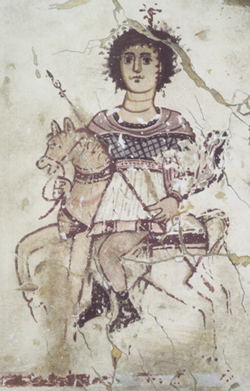ΠΡΟΣΩΠΟΓΡΑΦΙΕΣ ΑΠΟ ΤΗΝ ΕΛΛΗΝΙΣΤΙΚΗ ΚΑΙ ΡΩΜΑÏΚΗ ΑΙΓΥΠΤΟ
https://exhibitions.kelsey.lsa.umich.edu/galleries/Exhibits/textiles/classroom/class5b.html
Λεπτομέρεια από απεικόνιση τού Ήρωνος (Καρανίς, οικία B50, δωμάτιο E)
Compare the bent leg and horse blanket to the image in the large painting fragment from house 124.
After a painted photograph by Hamzeh Carr, ca. 1927
Kelsey Museum Archives, 4.2922
Photograph (colorized to match original appearance) of a mural from House B50 in Karanis, Egypt, from the 4th c. AD. (Source: Isis and Mary in early icons by Thomas F. Mathews and Norman Muller, in Images of the Mother of God: Perceptions of the Theotokos in Byzantium, edited by Maria Vassiliaki. Ashgate Publishing, 2005; pp. 5, 10.)
Ζωγραφική στις δύο πλευρές κόγχης: Ήρων και Ίσις με τον Αρποκράτη (οικία B50, δωμάτιο E)
Kelsey Museum Archives, 5.2159
Ίσις η Γαλακτοτροφούσα. Φώτο: Kelsey Museum of Archaeology/Wikimedia
Ο Αρποκράτης, με το δάχτυλο στα χείλη του, μας κάνει νόημα να σιωπήσουμε! ("διὸ τῷ στόματι τὸν δάκτυλον ἔχει προσκείμενον ἐχεμυθίας καὶ σιωπῆς σύμβολον", λέει ο Πλούταρχος, Plut. De Iside 378c ).
Εδώ έχουμε μια τοιχογραφία του 4ου μ.Χ. αιώνα, που βρέθηκε στην αρχαία αγροτική αιγυπτιακή κωμόπολη Καρανίδα, ιδρυθείσα από τον Πτολεμαίο Β’ τον Φιλάδελφο (308/9-246 π.Χ.). https://neoskosmos.com/el/232508/isida-i-galaktotrofousa/
Αριστερά : Παναγία Βρεφοκρατουσα, Δεξιά: Παναγία Γαλακτοτροφούσα
Μονή Χιλανδαρίου
The encaustic painting technique was first developed in Classical Greece.41 {Barr, ten Berge, van Daal, van Oppen 2019, p. 19}
Susan Walker pointed out that the linden wood on which many Fayum portraits were painted generally derives from southeastern Europe, thus including the heartland of the Macedonian veterans who settled in Egypt in the Hellenistic period.[43]
If Walker’s provocative suggestion were correct, it would indicate that the addition of panel portraits to mummies centuries later in the early Roman Imperial period could be understood as an expression of ethnic or cultural identity—a proud exclamation of the Graeco-Macedonian background of the wealthy upper-class inhabitants of the Fayum. {Barr, ten Berge, van Daal, van Oppen 2019, p. 19}
Η ΠΑΝΑΓΙΑ ΤΩΝ ΧΕΛΙΔΟΝΙΩΝ...
Από τις λίμνες της Αρσινοϊτιδος (Fayum) και τους κήπους της Αλεξάνδρειας, στα φλεγόμενα βράχια του θεοβάδιστου Σινά, με την δροσιά του αρχαίου Κόσμου ακόμη στα μάτια, αυτή είναι η παλιότερη (6ος αι.) Εικόνα της Παναγίας που μας σώθηκε, μαζί με την Πλατυτέρα της Αγίας Σοφίας η πιο αγαπημένη μου...
Κάπως έτσι μου φαίνεται θα ήταν η πρωταγωνίστρια αυτής της ιστορίας:
https://escholarship.org/uc/item/61x16383#page=112
Hart, M. L. 2016. “A Portrait of a Bearded Man Flanked by Isis and Serapis,” in Icon, Cult, and Context: Sacred Spaces and Objects in the Classical World, ed. M. K. Heyn, A. I. Steinsapir, Ann I, Cotsen Institute of Archaeology Press, pp. 79-89.
https://www.academia.edu/1547983/Sarapis_et_Ne%C3%B4tera_%C3%A9lus_parmi_les_dieux
Wahid Omran. "The Cult of Heron in Egypt," Art. International Journal of Heritage, Tourism, and Hospitality 9 (1), pp. 206-225.
Claytor, W. G. 2014. “Heron, Son of Satyros: a Scribe in the grapheion of Karanis," Zeitschrift für Papyrologie und Epigraphik 190, pp. 199-202.
https://www.mdpi.com/2076-0752/8/3/92
Barr, J., C. M. ten Berge, J. M. van Daal, B. van Oppen. 2019. "The Girl with the Golden Wreath: Four Perspectives on a Mummy Portrait," Arts 8 (3):92, pp. 1-30.
https://www.getty.edu/publications/mummyportraits/
"Mummy Portraits of Roman Egypt: Emerging Research from the APPEAR Project," ed. M. Svoboda and C. R. Cartwright
http://opar.unior.it/1674/1/Bragantini_Fayoum.pdf
Bragantini, I. 2011. "Fayum Painted Portraits," in Natural and Cultural Landscapes in Fayum. Safeguard and management of Archaeological sites and Natural Environments, october-november 2010, Fayum.
https://journals.plos.org/plosone/article?id=10.1371/journal.pone.0240900
Zesch , S., M. Gander, M. Loth, S. Panzer, M. Linda Sutherland, A. H. Allam, I. Badr, G. S. Thomas, S. Wetzig, A. Zink, W. Rosendahl. 2020. "Decorated bodies for eternal life: A multidisciplinary study of late Roman Period stucco-shrouded portrait mummies from Saqqara (Egypt)," PLoS ONE 15(11): e0240900
https://books.google.gr/books?id=35YXEAAAQBAJ&pg=PA138&lpg=PA138&dq=Susan+Walker+pointed+out+that+the+linden+wood+on+which+many+Fayum+portraits+were+painted+generally+derives+from+southeastern+Europe,+thus+including+the+heartland+of+the+Macedonian+veterans+who+settled+in+Egypt+in+the+Hellenistic+period.&source=bl&ots=J03NTBemeF&sig=ACfU3U2clZWsEPCdSbms9fCojrxUvV8rDQ&hl=el&sa=X&ved=2ahUKEwjIjJyi-IzyAhU1_7sIHeAaD_UQ6AEwAXoECAMQAw#v=onepage&q=Susan%20Walker%20pointed%20out%20that%20the%20linden%20wood%20on%20which%20many%20Fayum%20portraits%20were%20painted%20generally%20derives%20from%20southeastern%20Europe%2C%20thus%20including%20the%20heartland%20of%20the%20Macedonian%20veterans%20who%20settled%20in%20Egypt%20in%20the%20Hellenistic%20period.&f=false
Corcoran, L. H. 2021. "'They leave behind them portaits of their wealth, not themselfes': Aspects of self representations in the dress of the deceased in Mummy portaits and portait mummys from Roman Egypt," in Dress in Mediterranean Antiquity: Greeks, Romans, Jews, Christians, ed. A. J. Batten, K. Olson, London / New York, pp. 137-158.
https://www.tovima.gr/2008/11/24/opinions/ti-symbolizoyn-ta-portreta-toy-fagioym/?fbclid=IwAR0JQlbhQ3KJHvMCVt1UB_kb9lPc8v1iv-LF4x0_0DwP2k-uZK4e6TOTqlI
Τι συμβολίζουν τα πορτρέτα του Φαγιούμ
Doerner in 1921 describes a “wax paste” made with wax, pigment, and mastic and comments that “it is not impossible that the late Greek mummy portraits from the Fayum were made in that way.”19 [: Doerner 1934, 142. This 1934 edition is the first English translation of Doerner’s book; it was initially published in German in 1921] Similar combinations reappear in the 1990s in the influential work of Euphrosyne Doxiadis, supplemented by the results of her own painting experiments; she proposed that the artists used “hot beeswax … mixed with … Chios mastic, for instance” or “cold Punic wax … mixed with egg … and sometimes a small amount of linseed oil.”
https://www.mdpi.com/2076-0752/8/3/92/htm
Barr, J., C. M. ten Berge, J. M. van Daal and B. F. van Oppen de Ruiter. 2019. "The Girl with the Golden Wreath: Four Perspectives on a Mummy Portrait," Arts 2019, 8(3), 92; https://doi.org/10.3390/arts8030092
https://www.lifo.gr/culture/arxaiologia/35-sygklonistika-portreta-fagioym









Δεν υπάρχουν σχόλια:
Δημοσίευση σχολίου